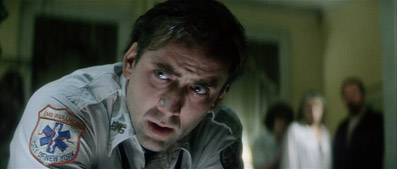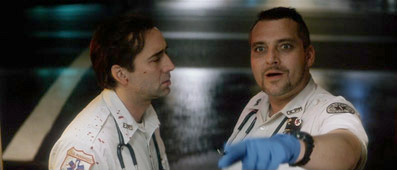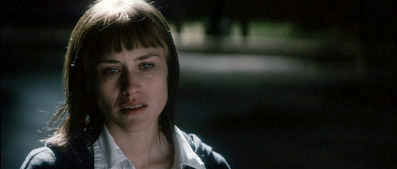|
Frank
Pierce is a New York paramedic on the brink of burn-out.
Haunted by ghosts from his past and unable to enjoy anything close to restful
sleep, he hasn't saved anyone in months and now longs to be fired so that he can regress into misery. Then
one night he and his partner respond to a cardiac arrest
where the victim they pronounce dead unexpectedly
responds to treatment. Frank becomes convinced that the man wants to
be allowed to die, which deepens his malaise, but he finds a
flicker of hope when he meets and connects with the victim's
daughter, Mary.
Director
Martin Scorsese and screenwriter Paul Schrader are two of the most important talents of modern American cinema.
On the two previous occasions that they have worked
together the results were history-making: the brilliant
Taxi Driver remains a landmark slice of 70s maverick
cinema and launched both of their careers in a major way, and four years later Raging Bull (which Schrader
co-wrote with sometime Scorsese collaborator Mardik Martin)
won worldwide acclaim and topped a critics' poll for Best
Film of the 1980s. Hopes were insanely high for this latest
work, the combination of Scorsese, Schrader and New York
streets creating expectations for a film that might actually outstrip
its predecessors in its rage and unflinching
brutality. So imagine the dismay when Schrader and Scorsese
delivered Bringing Out the Dead. Where Travis Bickle
and Jake LaMotta are driven by anger,
Frank Pierce is wrapped in a jacket of weariness and despair.
Jake and Travis burned with inner fury that sometimes exploded
in physical action, but Frank is on a self-obsessed downward
slide and is slowly imploding. If that wasn't enough, Schrader
and Scorsese refuse to push many of the standard story development
buttons. Though Frank's journey through his own neurosis
is aided by the expected female ray of hope, she turns out
to be every bit as screwed-up as him. And despite the three-act structure,
the story rarely develops along traditional narrative lines,
and this includes the ending. In retrospect, it's not that surprising
that a number of critics and many of Scorsese's traditional
supporters were a little pissed off. Which is a real shame,
because Bringing Out the Dead, though perhaps not
the cinematic event its predecessors were, is still a unique
and compelling work and every inch a Schrader/Scorsese film.

The
film takes place over three consecutive nights, each of which sees Frank
paired with a different partner, each of whom he has a history
with and whose lifestyle represents a potential but ultimately
self-deceptive future direction for Frank himself: overweight Larry
Verber treats his night work as a series of rest periods
and meal stops; relentlessly cheerful Marcus has found God;
and wide-eyed, manic Tom Walls is addicted to violence.
All three have the outward appearance of men at one with
their job and the city, but all are hiding behind self-created facades.
Larry's night-time meals have become his whole reason for
going out, and actually having to attend incidents annoys
him intensely – he'd rather park at the end of a pier and
sleep through his shift. Marcus appears genuinely happy,
but has achieved this state through reality denial, typified in his misguided conviction that the female dispatcher
wearily spilling out jobs has the hots for him,
and cemented by a hilarious scene in which he convinces a group
of half-stoned clubbers to pray for the life of their dead
friend to revive him, an action actually being
accomplished by Frank and a hypodermic.
Tom Walls displays an enthusiasm for his job that verges on manic, but he is a borderline psychotic who uses his
position as an authority figure to intimidate, frighten
and even beat the very people he is charged to save.
Beyond the confines of the narrative, all of this this could
be read as a comment on negative aspects of modern America,
with apathy, fast food, drugs, religion and violence (not
to mention underfunded health care) key contributors to
a potential breakdown of community life, notably in the way they are abused
by those with a personal agenda.
The
portrait of New York presented here is as dark as anything in
Taxi Driver, its streets controlled by drug dealers
and infested with the dispossessed, the predatory and the
downright dangerous; at one point Frank's ambulance has to wait for
a series of drug deals to conclude before being casually and
reluctantly allowed to pass. Mercy Hospital, to which Frank
regularly returns, is a medical facility at breaking point,
the staff unable to cope with the deluge and patients left on trolleys
in corridors, all waiting for a bed that may never become available, its reception beseiged by angry relatives
and potential patients who are held at bay by a
lone, agitated security guard whose ultimate threat is that
he will remove his sunglasses. One call to a derelict
apartment block prompts an initial reluctance to enter without
police backup, and when Frank and Marcus do go in they seem
to ascend through layers of an inverted hell. A dark, sinister,
unlit stairwell peppered with broken drug phials leads them to the gloomily tattered remains of an apartment
in which a young girl named Maria is about to give birth
to twins, despite the fact that she has apparently never
had sex. It's a bible story that feeds Marcus's religion but
turns sour for Frank when it's the twin he delivers that
dies, reaffirming his lack of belief in himself. He no longer
sees himself as someone who can save others – in his voice-over
he describes himself simply as a 'grief mop' and feels that in the mahority of cases, it's simply enough that he shows up at all. Seemingly, the only calm
in this social storm is The Oasis, an apartment owned by
drug dealer Cy, where clients can not only purchase a variety
of mind-altering substances but can chill out or even sleep
for a few hours. As seemingly the only dealer who refuses
to handle the deadly and overly symbolic 'Red Death',
he comes across as almost morally sound in comparison to
those around him.

All
of which sounds seriously depressing stuff, but balancing
this is a very nice line in black humour, a wealth of captivating character detail and Scorsese's sometimes dynamic technical
handling. Occasionally he overplays his hand – UB40's Red
Red Wine playing over shots of blood running from a shooting
seems a tad clunky, and the ghost of Rose, a girl Frank
once failed to save, makes a few too many appearances. But when he hits gold the results are electrifying, as in
the supercharged sequence in which the Frank and Walls,
both fired up, propel themselves furiously into the night
to the sounds of The Clash's Janie Jones. Essential to
this are Robert Richardson's glowing, almost hallucinatory
night-time photography and Thelma Schoonmaker's sometimes
dazzling editing, which itself has become as much a part
of Scorsese's style as the direction itself.
Performances
throughout are first rate. As Pierce, Nicholas Cage is close to his
Leaving Las Vegas best, coming across as
an authentically tortured soul, his face and body language
expressing a genuine weariness with life and the world around him, his eyes
seemingly pleading for salvation. Even his more manic moments,
such as his anger at the would-be suicide who fails to do
the job properly, have a genuine desperation to them. Patricia
Arquette is appropriately downcast as Mary, but the real
drive come from three key supporting roles. John Goodman
is almost stereotypically cast as Larry, his bulk and casual
attitude making it easy to believe he feeds and sleeps his
way through shifts, but he's still a joy to watch. He also invests the role with real humanity, something best caught in an almost throwaway moment during Frank's flashback
memory of Rose's death, a time we can presume when Larry still
really cared, the very real concern on his face as they
fight to save their patient being that of a committed professional.
Those who know Ving Rhames primarily for his role as slow-talking
gangster Marcellus Wallace in Pulp Fiction will have
trouble even recognising him here as the cheerfully religious
Marcus – the transformation in both look and character demonstrates
all too well the actor's range, and while Tom Sizemore may
also be in danger of being typecast as the half-crazed Tom
Walls, the wide-eyed energy with which he plays the role
makes it hard to imagine anyone else working half as well;
his borderline madness is at once both amusing and borderline frightening.

Bringing
Out the Dead is a seriously underrated, too often overlooked
film from two of the most consistently fascinating talents
working in modern US cinema, and a welcome change from the
shouty, obvious, CGI-driven action dramas that have become
the dominant Hollywood norm. It also offers a view of modern,
street-level urban America that is refreshingly critical,
as befits the two once angry young men behind it. They may be
older and wiser, are clearly no less critical.
Touchstone's
region 2 disk is about the film and nothing else, and the
lack of extras is in some way compensated for by the picture
and sound quality. Shot almost entirely at night (the daytime
scenes, such as they are, take place in a gray murkiness
that reflects Frank's melancholy), but processed in a way
that produces a pronounced glow to deliberately overexposed
white highlights, this could prove a major challenge for
DVD, but the transfer here is first rate – the contrast
range, shadow detail and colour rendition are all excellent,
and there is no sign of edge enhancement or intrusive artefacting.
Reviews of the region 1 disk suggest that the region 2 has
the edge here. The picture is 2.35:1 and anamorphically
enhanced for widescreen TVs.
The
5.1 sound mix has an impressive breadth and clarity, the
music that is so essential to the film – whether it be Elmer
Bernstein's moody score or the various rock numbers that
accompany Frank on his missions into the night – playing
particularly well. Distant city sounds linger nicely in
the background in all scenes outside the ambulances, sometimes
hauntingly so. Surprisingly, the rear speakers are very
low key, as is the subwoofer – though fine for the most
part, the sequence in the night club almost demands that
both be used aggressively.
As
mentioned in the previous section, this is almost as far
from the term 'special edition' as you can get, and the
DVD cover spine has that curved 'wide screen' banner that
used to translate, with the aid of those glasses from They
Live, as 'no extras'. Here there is one, the standard
electronic press kit running just under 11 minutes. Made
up from interviews with principal cast members, Scorsese
and Joe Connelly, the real-life paramedic on whose book
the film was based, it does give a few snippets of info
into the reasons for creating the book and film, but also
has a lot of back-slapping typical of this sort of featurette
and overall is of little value.
Though
a seemingly increasing number of critics (online and otherwise)
are prepared to stand up for this fine film, it remains an unfairly maligned work in some quarters, in part because it lacks the
in-your-face drama and explicit violence of many of the
director's previous New York films. Bringing Out the
Dead requires a more patient viewer, and despite
its setting is altogether more European than American in
its sensibilities, an instant barrier for a sizeable proportion
of its potential US audience. It won't have students standing
in front of mirrors with fake guns reciting "Are you
talking to me?" at their own reflection, but that's
no bad thing, and taken on its own merits rather than as
a comparative work, this is an intelligent, emotive piece
of cinema that deserves a wider audience. Extras are virtually
non-existent, and maybe one day someone like Criterion will
do something about that, but the picture quality is first
rate and the sound generally impressive, which for fans
of the film will be enough for now.
|